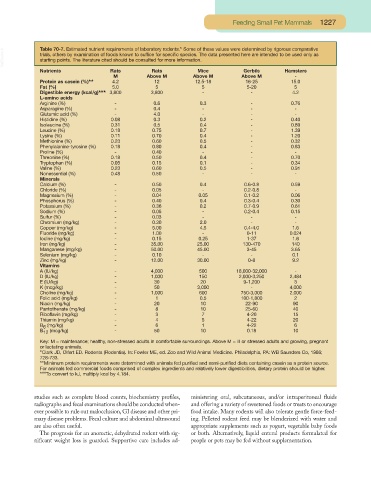Page 1177 - Small Animal Clinical Nutrition 5th Edition
P. 1177
Feeding Small Pet Mammals 1227
VetBooks.ir Table 70-7. Estimated nutrient requirements of laboratory rodents.* Some of these values were determined by rigorous comparative
trials, others by examination of foods known to suffice for specific species. The data presented here are intended to be used only as
starting points. The literature cited should be consulted for more information.
Nutrients Rats Rats Mice Gerbils Hamsters
M Above M Above M Above M -
Protein as casein (%)** 4.2 12 12.5-18 16-25 15.0
Fat (%) 5.0 5 5 5-20 5
Digestible energy (kcal/g)*** 3,800 3,800 - - 4.2
L-amino acids
Arginine (%) - 0.6 0.3 - 0.76
Asparagine (%) - 0.4 - - -
Glutamic acid (%) - 4.0 - - -
Histidine (%) 0.08 0.3 0.2 - 0.40
Isoleucine (%) 0.31 0.5 0.4 - 0.89
Leucine (%) 0.18 0.75 0.7 - 1.39
Lysine (%) 0.11 0.70 0.4 - 1.20
Methionine (%) 0.23 0.60 0.5 - 0.32
Phenylalanine-tyrosine (%) 0.18 0.80 0.4 - 0.83
Proline (%) - 0.40 - - -
Threonine (%) 0.18 0.50 0.4 - 0.70
Tryptophan (%) 0.05 0.15 0.1 - 0.34
Valine (%) 0.23 0.60 0.5 - 0.91
Nonessential (%) 0.48 0.50 - - -
Minerals
Calcium (%) - 0.50 0.4 0.6-0.8 0.59
Chloride (%) - 0.05 - 0.2-0.8 -
Magnesium (%) - 0.04 0.05 0.1-0.2 0.06
Phosphorus (%) - 0.40 0.4 0.3-0.4 0.30
Potassium (%) - 0.36 0.2 0.7-0.9 0.61
Sodium (%) - 0.05 - 0.2-0.4 0.15
Sulfur (%) - 0.03 - - -
Chromium (mg/kg) - 0.30 2.0 - -
Copper (mg/kg) - 5.00 4.5 0.4-4.0 1.6
Fluoride (mg/kg) - 1.00 - 0-11 0.024
Iodine (mg/kg) - 0.15 0.25 1-37 1.6
Iron (mg/kg) - 35.00 25.00 130-470 140
Manganese (mg/kg) - 50.00 45.00 3-45 3.65
Selenium (mg/kg) - 0.10 - - 0.1
Zinc (mg/kg) - 12.00 30.00 0-8 9.2
Vitamins
A (IU/kg) - 4,000 500 18,000-32,000 -
D (IU/kg) - 1,000 150 2,000-3,250 2,484
E (IU/kg) - 30 20 9-1,200 3
K (mcg/kg) - 50 3,000 - 4,000
Choline (mg/kg) - 1,000 600 750-3,000 2,000
Folic acid (mg/kg) - 1 0.5 100-1,800 2
Niacin (mg/kg) - 20 10 22-90 90
Pantothenate (mg/kg) - 8 10 25-60 40
Riboflavin (mg/kg) - 3 7 4-20 15
Thiamin (mg/kg) - 4 5 4-22 20
B (mg/kg) - 6 1 4-22 6
6
B 12 (mcg/kg) - 50 10 0.18 10
Key: M = maintenance; healthy, non-stressed adults in comfortable surroundings. Above M = ill or stressed adults and growing, pregnant
or lactating animals.
*Clark JD, Olfert ED. Rodents (Rodentia). In: Fowler ME, ed. Zoo and Wild Animal Medicine. Philadelphia, PA: WB Saunders Co, 1986;
728-733.
**Minimum protein requirements were determined with animals fed purified and semi-purified diets containing casein as a protein source.
For animals fed commercial foods comprised of complex ingredients and relatively lower digestibilities, dietary protein should be higher.
***To convert to kJ, multiply kcal by 4.184.
studies such as complete blood counts, biochemistry profiles, ministering oral, subcutaneous, and/or intraperitoneal fluids
radiographs and fecal examinations should be conducted when- and offering a variety of sweetened foods or treats to encourage
ever possible to rule out malocclusion, GI disease and other pri- food intake. Many rodents will also tolerate gentle force-feed-
mary disease problems. Fecal culture and abdominal ultrasound ing. Pelleted rodent feed may be blenderized with water and
are also often useful. appropriate supplements such as yogurt, vegetable baby foods
The prognosis for an anorectic, dehydrated rodent with sig- or both. Alternatively, liquid enteral products formulated for
nificant weight loss is guarded. Supportive care includes ad- people or pets may be fed without supplementation.

